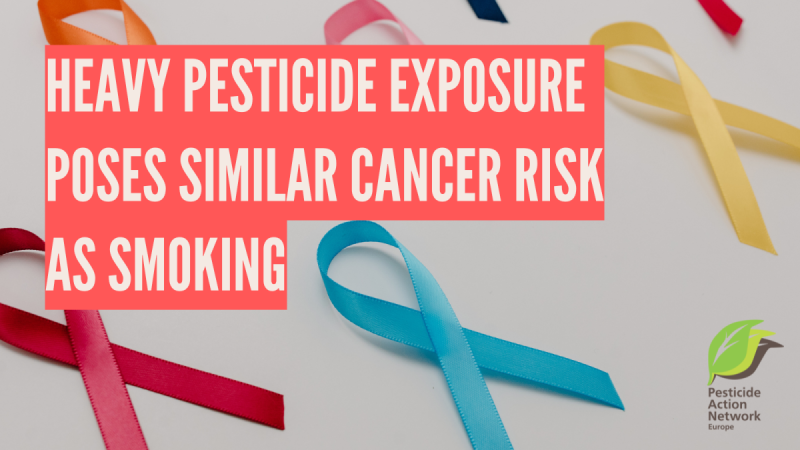Today is World Cancer Day. We all know the link to tobacco, but what about pesticides? A new U.S. study found that living in agricultural areas with heavy pesticide exposure can raise cancer risk just as much as smoking. So why are at least 15 suspected carcinogenic pesticides still approved? And why are pesticides not mentioned in EU anti-cancer plans?
The US nationwide population-based study was published in Frontiers in Cancer Control and Society. It shows that not only farmers but entire communities are affected by the carcinogenic risk associated with pesticide exposure. [1] According to the researchers, it is the first large-scale study examining the big picture, comparing pesticide use with a cancer risk factor that is no longer in question: smoking. In fact, in three cancers examined – non-Hodgkin’s lymphoma, leukaemia and bladder cancer– the effects of pesticide exposure were more pronounced than those of smoking.
The study covers a total of 69 pesticides for which data is available in the U.S. It takes into account that people on a daily basis are exposed not just to a single pesticide, but to a "cocktail" of many.
Pesticides classified as suspected carcinogens in the EU
In the EU, there are still at least 15 substances approved that have been classified as suspected carcinogens (Category 2). Two of the substances covered by the US study - 8-Hydroxyquinoline and Tebuconazole - are included in our Toxic 12, a list of the most toxic chemicals still authorized in the EU that need to be banned immediately. [2] Two others, such as trifloxystrobin and fluopicolide, are PFAS—hazardous "forever" chemicals. If they do degrade, most end up as trifluoroacetic acid (TFA), a small PFAS that is highly soluble and is present in the majority of European water systems, alarmingly. [3] The report also includes glyphosate, classified as a probable carcinogen by the International Agency for Research on Cancer of WHO but was approved by the EU for 10 years more in 2023 - a decision that PAN Europe and its members are challenging at the European Court of Justice. [4] Europe failing to classify glyphosate as carcinogen, despite the scientific evidence, raises questions whether there are more carcinogenic substances approved that haven’t been properly classified.
On this World Cancer Day, we expect the European Commission to proudly highlight the Beat Cancer Plan - an initiative designed to fight against the illness from prevention to early detection. However, while the EU rightly focuses on tackling major causes such as tobacco, alcohol, and pollution, pesticides are not even mentioned in this plan. This should change now. The power lies in the hands of EU policymakers. With the proper implementation of this existing legislation, we could effectively ban the pesticides harmful to human health and the environment and eliminate this widespread cause of cancer.
Notes:
[1] Pesticides potentially as bad as smoking for increased risk in certain cancers
[3] Toxic industry lobby tries to block PFAS restrictions
[4] Next step: glyphosate approval is brought to the European Court of Justice
List of EU allowed pesticides linked to cancer:
|
Aclonifen ( two PBT criteria) |
| Amisulbrom |
| Bupirimate |
| Captan |
| Chlorotoluron (endocrine disrupting properties, two PBT criteria) |
| Folpet |
| Forchlorfenuron |
| Imazalil (aka enilconazole) |
| Kresoxim-methyl |
| Lenacil ( two PBT criteria) |
| Metazachlor |
| Pirimicarb ( two PBT criteria) |
| Propyzamide ( two PBT criteria) |
| Proquinazid |
| Quizalofop-P-tefuryl |
